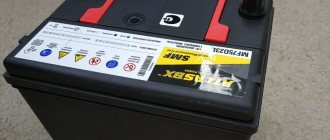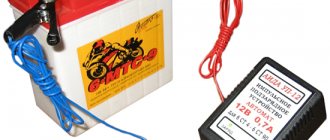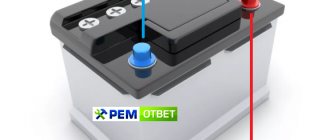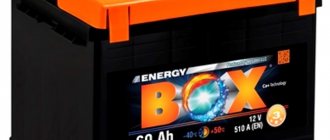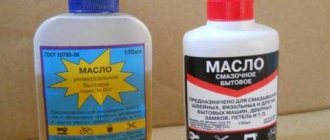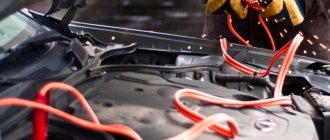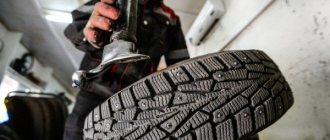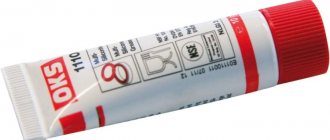Winter is a traditional time when both we and our readers turn to battery charging issues. We have already touched on this topic more than once and, it would seem, have covered it completely. But no, questions arise from time to time! Sometimes they are quite unexpected.
Needless to say, we have thoroughly studied the topic. We told you how to determine that it is time to change the battery , and if the battery is still in order, then how to extend its life ; We revived a dead battery , and also figured out how to “light” a car with a discharged battery and whether it was worth doing it... But then life threw up a new situation, and a completely banal one.
A gloomy morning, frost at -25, several attempts to start the car - and now you are taking the battery home to charge. Before you put on the “charger” contacts, clean the terminals - a certain amount of oxides and dirt has probably accumulated on them. Charged the battery, installed it, started it... you're ready to go! And the contact groups at the battery connection points, those same “minus” and “plus”, remained dry. Do they need to be lubricated? For what? What to lubricate with? How?
It must be said that on all these seemingly quite simple issues, disputes do not subside among “experienced” people - imagine, this is one of those automotive topics on which one can argue endlessly. We, without delving into, in particular, the secret knowledge of Kabbalah and fortune telling on motor oil sediment, decided to give some kind of average, one hundred percent guide on these issues. It will be useful for both beginners and experienced people, because such questions are raised infrequently these days - as a rule, we all climb under the hood of a car no more often than is required to top up the washer fluid.
In fact, the terminals do not need to be lubricated. In the sense that, in principle, you can’t really take care of a modern car - at the very least, it can drive for some time without any maintenance at all. Current car electrical circuits and, in particular, batteries are designed in such a way that they require much less preventive maintenance than before. However, the laws of physics and, in particular, the passage of time cannot be deceived - if the terminals are not lubricated, problems, including quite serious ones, will gradually begin to make themselves felt. Therefore, the answer here is this: you don’t have to lubricate it, but it’s much better to do it anyway.
Over time, oxides appear on the contact groups, which by themselves do not conduct electric current. In addition, dust and dirt accumulate in the engine compartment, some of it settles on the terminals and adds electrical resistance at the contact points. The consequence of these processes is a decrease in battery performance, decreased energy and difficulty starting. Some motorists prefer not to lubricate the terminals, but simply clean them periodically with fine sandpaper. But our task is to protect, “preserve” the terminals, keeping them in more or less pristine condition, so that later we do not have to get rid of oxides and dirt mechanically - this is not a very pleasant and fleeting process.
Until about the 1970s, drivers used exclusively solid oil, nigrol or lithol for these purposes. The latter can still be easily found on sale under the full name “Litol-24”. With the advent of VAZ cars, technical Vaseline was developed, which is also used today. Lithol and Vaseline are good, but they are easily washed off with shampoos and, in general, compared to modern products, they form a less durable film. Therefore, you can use more advanced auto chemicals - in the store we ask: “lubricant for electrical contacts” or “lubricant for battery terminals.”
Many manufacturers have such lubricants, they are red, blue or light blue, which makes it easier for you to understand whether there is a sufficient protective layer on the terminal. Lubricants are divided into conductive and non-conductive. In addition, ordinary graphite grease, which also conducts current, can be used to protect the terminals. And it seems that conductive lubricants are better in this case. However, as we can see from the next paragraph, the property of conductivity should not be placed at the forefront, because we lubricate not the contact area, but the external surfaces.
This mistake, oddly enough, is quite common - out of ignorance, a person lubricates the pole terminals on the battery, and then installs the terminals on them. In this way, you can get a dried film of lubricant that does not conduct current at all where it really needs to be conducted.
You need to do exactly the opposite: put on the terminals, tighten them tightly and only after that apply lubricant - in a word, you need to lubricate the terminals on the wires, especially on the outside, and the upper ends of the terminals. If you use modern lubricant in an aerosol can, the resulting “cap” can be smoothed out a little. Of course, it is better to carry out all work with gloves.
It is necessary to lubricate the terminals, and, to put it in very simple words, this is necessary so that there is good contact, so that there are no losses due to a poor connection. Firstly, the appearance of oxides leads to energy losses, and problems may arise during startup. And secondly, the resistance on the contact group increases, which means heat is generated, which can lead to dire consequences, including melting of the pole terminals of the battery and even the case. Before lubricating the terminals, they must be cleaned - with regular sandpaper or using special tools that are now on sale. Any water-repellent lubricant is suitable for lubricating the terminals.
What else?
Finally, a few tips that will make life a little easier for you and your battery. We touched on some of them in one way or another, but now let’s summarize.
- Before lubricating the battery terminals, it is necessary to clean both them and the pole terminals of the battery itself. This should be done either with a rag (if there is only dirt, without oxides), or with the finest sandpaper, or with special devices - there are “brushes” on sale, both external and internal, for cleaning both terminals and pole terminals. When using brushes, the operation takes a matter of seconds.
- After being placed on the battery terminals, the terminals need to be tightened tightly - the contact is good only if it is metal-to-metal contact! The terminals should not be loose - these are additional, completely unnecessary chances for dirt and oxides to get into the contact area.
- Some old-fashioned methods still work! In specialized stores that sell and service batteries, ask for protective felt rings - such “washers” soaked in oil are placed on the pole terminals, under the terminals. They protect the most critical places around the pole terminals - this is where acid can evaporate from the battery and settle in the form of oxides on the metal. Agree, the prospect of being unable to remove a dead battery due to tightly “acidified” terminals is completely useless to you.
Battery terminals are small but important parts, without which the operation of the car battery, and therefore the entire electrical system of the car, is impossible. Car enthusiasts often forget between one maintenance and another to take care of the proper operation of down conductors. As a result, the spare part fails due to oxidation and increased heating. This leads to detrimental consequences for the car and its owner. Possessing a high resistivity and a voltage power of up to 600V, failure of the battery contacts can lead to the melting of nearby plastic elements. There is a risk of fire not only for one part, but also for the machine as a whole. Let's look at the question in more detail.
How to lubricate battery terminals
The question of “how to lubricate battery terminals” has many controversial issues that are discussed by car enthusiasts. One of the common ones is “is it possible to lubricate the terminals with lithol.” Soviet car owners are advised to use lithol to prevent oxides on battery parts, but in the age of modern technology, doubts arise in the use of this product. Modern car enthusiasts (for processing electrical terminals) use modern spray cleaners with an oil-based composition and greases. Most people prefer the latter, as they provide a denser and more durable coating. New “miracle products” will not protect battery cells from oxide forever, but will only extend their service life.
It is important to know! The use of petroleum jelly, grease and lithol is still applicable in practice, but these products are not resistant to shampoos used when washing cars. Their durability on the surface of the part is significantly lower than that of modern products.
When choosing a good lubricant, you need to pay attention to the following criteria:
- acid resistance;
- tightness;
- viscous consistency;
- do not cause disordered movements of currents;
- work at different temperatures.
Unfortunately, not a single product fully meets all the necessary standards, so the car owner himself chooses what to sacrifice from the huge number of options on the market. In addition to the basic properties, there are several types of lubricants:
- Silicone grease has one drawback: increased fluidity. Otherwise, the product has the necessary qualities, including a temperature range of up to -60C, which is indispensable in the domestic climate.
- Teflon-based lubricant It is an analogue of the “liquid key” product. Due to the silicone in the composition, it is discussed by car enthusiasts on forums. But in the context of application in solving the problem of protecting parts, it is not worth considering.
- Oil-based lubricants and sprays are the most effective means of preventing oxide formation. There are a large number of professional products on the modern market, but some car enthusiasts resort to “old-fashioned” methods and use grease, petroleum jelly and cast oil to treat down conductors. Cyatim 201 also has the necessary qualities. Affordable price, quick drying, resistance to low temperatures, strong dielectric properties - everything you need for processing terminals.
- Copper greases High viscosity and resistance to high temperatures are the main advantages of the product. Motorists note the long-lasting effect of preventing the oxidation process. Also created on an oil base.
- Wax products have a high dielectric capacity and increased tightness with the surface.
- Some auto users use graphite lubricant for their cars, but the product has a high density and does not allow current to pass through. The car owner does not want the risk of overheating and fire of spare parts, so graphite lubricant is not recommended for these purposes.
How to lubricate the terminals to ensure contact and protect them from oxidation?
Let's consider what actions to take to prevent the terminals and wire tips from oxidizing.
Here it is worth highlighting several groups of products:
- "Grandfather" methods
. This implies the use of time-tested lubricants - Nigrol, Litol or grease. After cleaning the terminals and pulling them tightly, a lubricating compound is applied to the surface. With proper processing, reliable protection against breakdown and leakage for 6-8 months is provided. - Vaseline
is another effective means of protecting against potential oxidation problems. The use of technical and pharmacy versions of the product is allowed. But many experts are skeptical about Vaseline (unlike grease). The reason is that it protects the metal surface from moisture and prevents the terminal from sticking to the battery terminal. The main disadvantage of Vaseline is its high resistance, which causes problems with conductivity. To avoid complications, it is recommended to add a graphite-based lubricant to the composition. - Machine oil
. This method of protection is intended for the laziest car owners who do not want to spend time looking for lubricant or money to buy it. Each time you check the oil level, apply a small amount of oil to the terminal (to prevent the terminals from oxidizing). If you do this work regularly, the battery will not need maintenance soon. - Solid oil
. This option is considered one of the simplest and most accessible. But many car owners make a mistake - they apply a lubricant between the wires and battery terminals. Subsequently, under the influence of high temperatures, the lubricating composition hardens and sets, and a dense and dry crust appears. Its peculiarity lies in the inability to conduct current, which increases the risk of loss of contact. In the future, cleaning off the hardened composition is a real problem. By the way, such difficulties can also be encountered when using other lubricating compounds (including modern ones).
How to properly apply lubricant to battery terminals
Battery terminal lubricant performs protective functions, but does not remove oxide from the surface. Therefore, applying the product over the lesion will not solve the problem; on the contrary, it will worsen the situation. To avoid wasting material and damaging a car part, adhere to the following sequence:
- Disconnect the terminal from the network;
- Clean with sandpaper (mild abrasive);
- Spray or smear (depending on the product used) the product on the outside of the element;
- Reinstall the part.
When asked whether to lubricate the terminal with a protective agent or not, the answer is a resounding “yes,” since the use of such products extends the life of the car. The failure of a car part on the road is a dangerous event for the lives of passengers, so you should be as careful as possible in servicing individual parts.
Application process
The nuances of applying branded products are indicated on their packaging. But usually the process of using protective compounds to lubricate battery terminals has a general procedure. To begin with, mechanical cleaning of the elements is carried out:
- The crimp bolts are unscrewed. The terminals are disconnected, treated with a liquid containing alcohol (you can use a solvent diluted with water). The parts are wiped dry. Any ingrained acid residues are removed with a sponge soaked in a solution with soda (1 tablespoon per glass of water). The terminals are wiped with a damp cloth. with a napkin. The parts are processed with fine sandpaper. For initial cleaning, you can use a wire brush. Such a tool is sold in specialized auto parts stores.
Contacts cannot be cleaned using WD products and acetone. They contain aggressive conductive components.
The next step is to directly lubricate the terminals:
- The contact areas are initially treated with a silicone compound. The terminals are coated with a thin layer of the selected protective agent. This step can be skipped if the cells are often disconnected to recharge the battery. The terminals are put on and crimped. The lubricant is applied to all areas not protected by a dielectric. Remaining drops and smudges of the substance on the battery and car body are removed.
The problem of oxidation of battery terminals will be on the motorist’s agenda for a long time. Care products for these elements are traditional, affordable and effective, so you should not neglect them.
Video about lubricating battery terminals
1200 rub. for the photo report
We pay for photo reports on car repairs. Earnings from 10,000 rubles/month.
Write:
Before you understand how you can lubricate the battery terminals, you should understand the question: why lubricate them. And they lubricate the battery terminals of cars so that a white coating (oxide) does not form on them. The oxidation itself occurs from electrolyte vapors and under the influence of other aggressive environments, which include air (it contains oxygen). The oxidation process is invisible at first, but negatively affects the operation of the battery. So much so that it can begin to quickly discharge (due to current leakage), there will be a problem with starting the engine, and then you will have to completely restore the terminals. Want to avoid this?
TOP 5 lubricants for battery terminals
So, of all the lubricants under consideration, not all are very effective and truly worthy of praise, so with more than 10 compositions, only 5 of the best terminal care products can be identified. Their assessment is a subjective opinion, based on such criteria as: reliability of the layer - how much it protects the terminals from corrosion and oxides (direct purpose), retention time elimination of sliding discharges, simplicity of the application process, wide temperature range of operation.
| Lubrication | Base type | Viscosity | Operating temperature,℃ | Tightness | Acid resistance |
| Molykote HSC Plus | Oily | High | -30°C… +1100°C | High | High |
| Berner battery pole spray | Oily | average | -30°C… +130°C | High | High |
| Presto Batterie-Pol-Schutz | Wax | average | -30°C… +130°C | High | High |
| Vmpauto MC1710 | Oily | High | -10°С… +80°С | High | High |
| Liqui Moly Batterie-Pol-Fett | Oily | High | -40°C… +60°C | High | High |
A high-quality terminal lubricant should have a whole range of properties:
- Acid resistance
. The main task: to prevent the development of oxidative processes, to stop those that have already begun. - Tightness
. The product must simultaneously displace moisture, condensation, and protect against oxygen! - Dielectricity
. Eliminating the occurrence of stray currents allows you to use battery power economically and efficiently. - Viscosity
_ One of the important quality criteria. Excessive fluidity may not have the best effect on battery protection: under high temperature operating conditions, thermal decomposition of lubricant molecules occurs, and you will have to apply it to the terminals again. - Wide operating temperature range
. The car is operated in different temperature conditions, so the terminal care product must retain its properties at both low and high temperatures. And it is desirable that it retains its viscosity.
As you can see, even the list of basic requirements for high-quality lubricants is quite long, and not a single product can fully meet all the requirements at the highest level. Some seal better, but collect dust and dirt, others do a good job of preventing the development of the oxidation process, but wash off too easily, and so on. The modern market presents a large selection to your attention, and it is yours. But before purchasing a lubricant, it would be a good idea to list the types of lubricants based on their basis.
How to lubricate terminals from oxidation
The main purpose of lubricating electrical connections is to prevent dirt and air oxygen from entering the contact area, which helps prevent them from oxidizing.
It is desirable that the protective coating does not collect excess dirt and performs its protective functions for as long as possible. There are many different options for protecting battery terminals, each of which has certain advantages and disadvantages. The main condition should be the absence of a corrosive effect on contacts, wire insulation and surrounding rubber parts, high temperature and acid resistance.
Graphite lubricants
These are compositions, usually based on mineral oil with the addition of graphite powder. They have good water-repellent properties and excellent protection against corrosion. A regular graphite lubricant can withstand temperatures from -20 to +70 degrees, but there are also more expensive high-temperature options. Due to possible overheating of the engine compartment in hot weather, it is better to use them.
Graphite is a good conductor of electric current, so its penetration into the contact joint does not degrade the electrical contact as much as a grease with dielectric properties does.
Graphite lubricants
Greases
This type of lubricant can withstand high temperatures, has anti-corrosion properties, adheres well to the surface, but does not conduct electricity. They are made on an oil basis with the addition of special additives and dyes that facilitate the application of a protective coating.
This is a good option for protection against oxidation when using special protection compounds, for example from LiquiMoly, Addinol, Molykote, Gunk and others.
Greases
Copper greases
These lubricants are durable, have high viscosity, conduct electricity well, withstand high temperatures (from -35 to several hundred degrees), and provide excellent protection against corrosion, moisture, and burnouts.
Special copper lubricants for electrical contacts are available in the form of sprays, for example, Berner, as well as copper dabs for highly loaded moving joints. They have different properties, but both options can be used to protect battery contacts.
Wax-based lubricants
These lubricants can withstand temperatures from -30 to +130 degrees, have a medium viscosity, adhere well to the surface and provide high tightness of electrical contacts.
A good wax-based composition is Presto Batterie Pol Schutz, which can withstand temperatures from -30 to +130 degrees and is easily applied using an aerosol spray.
Wax-based lubricants
Silicone lubricants
This is an excellent option for protecting contact connections with good resistance to hot vapors and disinfectant solutions. Silicone grease adheres well to surfaces, is neutral and can work over a wide temperature range from -40 to +150 degrees. Produced by many trusted manufacturers, including Shell, Fuchs, Molykote, Roco and others.
The disadvantage of silicone lubricants is the need to regularly renew the protective coating.
Silicone lubricants
Oil-based formulations
These include such common compounds as solid oil, litol, cyatim 201, and petroleum jelly. These compounds are used to protect rubbing surfaces from wear; they have high fluidity, which increases with increasing temperature in the engine compartment, so they are not very suitable for protecting electrical contacts. If there are serious problems with contact oxidation, they can be used to protect the terminals, but it is better to do this only in the winter season, when these lubricants are less fluid.
There are special formulations based on mineral oils containing special additives that improve their temperature resistance and therefore make it possible to use them to protect terminals. These include:
- Liqui Moly Kupfer Spray is an oil lubricant with copper powder added, designed for brake pads. It can also be used as a protective coating for the outer surface of contacts;
- Liqui Moly Batterie Pol Fett is a special protective lubricant with red dye. Permissible temperatures are from -40 to +60 degrees.
- Vmpauto MC1710 is a mixture of various oils, as well as silicone with a blue dye. Can be used at temperatures from -10 to +80 degrees.
Oil-based formulations
Teflon lubricants
These lubricants are designed to form a dry coating on the rubbing parts. They are not very suitable for protecting electrical contacts due to their high penetrability, which can impair electrical contact.
When to lubricate battery terminals
It is necessary to smear the battery terminals not when a layer of white oxide has already appeared there, but preferably before installing the battery or at least at the very beginning of the oxidation process. On average, terminal maintenance measures are required every two years. On modern maintenance-free batteries that do not require so much attention, the need to lubricate the terminals may arise after 4 years of operation. Although, by and large, it all depends on environmental conditions, the condition of the electrical wiring and battery. Since damage to the terminals, poor contact, overcharging from the generator, violation of the seal of the housing and the ingress of technical fluids only contribute to the formation of plaque.
How to understand that the oxidation process has already begun
In order to check whether the oxidation process has already begun at the terminals, you will need to prepare a 10 percent soda solution. Add to 200 ml. container with plain water, one and a half to two tablespoons of soda, stir and moisten the terminal with it. If oxidation has begun, the solution will neutralize the remaining electrolyte. The process will be accompanied by the release of heat and boiling. So, it's time to put our advice into practice.
Oxidized car battery terminal
But an indirect sign of an ongoing oxidation process is:
- reduction of the on-board network voltage level when starting the engine;
- increased battery self-discharge.
So, if you notice these problems, then to eliminate them you will definitely have to clean and lubricate the battery terminals. But for this there is a certain sequence, rules and tools.
Causes of oxidation
Having understood the types of lubricants, you should find out why the battery terminals oxidize. In fact, there are a number of reasons, here are the main ones:
- Poor contact between the end of the wire and the battery itself. During operation, a gap has appeared into which vapors from the electrolyte enter. The damage just needs to be sealed.
- The terminal cover is scratched or worn off. Replacement required.
- The battery terminal is not sealed. The electrolyte leaks out and the surface of the contact assembly is corroded.
- The generator is recharged. In this case, you should go to specialists.
If the battery terminals are constantly oxidizing, what should you do? It was said above how to behave in the case of the above reasons. But what to do when the oxidation became so strong that the car stopped starting. In this case, it is necessary to clean the terminals. To do this, take sandpaper and carefully rub off the plaque. Be extremely careful not to damage the insulating sheath. Perform work with gloves. For better contact, use one of the lubricants discussed above.
When the positive terminal oxidizes, this can happen for the following reasons:
- The battery seal is broken somewhere. It is necessary to intervene in the situation urgently, because over time the acid can eat through the body without any problems.
- The battery was systematically recharged, which led to overheating of the electrolyte and, as a result, it began to evaporate too actively. In this situation, there is nothing left but to go to the car market or auto store to buy a new device.
What to lubricate with? At the beginning of the article, the most popular lubricants of both old and new types were given. You only need to add liqui moly battery terminal lubricant. Among its features, it is worth noting the reliable protection of contacts from corrosion. The motor will work in any weather conditions. The most important thing is that the battery life is increased by almost two and a half times. This lubricant prevents current leakage. Before applying it, you should thoroughly clean the required area. Again, use a knife or sandpaper, as described earlier.
As you know, the battery is one of the main elements necessary for the normal operation of a car. Failure or incorrect operation of the battery will in one way or another affect the functioning of the vehicle as a whole. In this article we will talk about battery prevention, in particular, about solving the problem of oxidized contacts.
[Hide]
How to lubricate battery terminals
The process of lubrication of terminals consists of cleaning parts from oxidation products and then treating them with lubricants and is carried out in the following order:
- We remove the terminals.
- We remove oxidation products with a brush or felt soaked in soda solution. If the oxidation process started a long time ago, you will have to use terminal brushes.
- Rinse with distilled water.
- We tighten the terminals.
- Treat with the chosen product.
How to clean terminals
- Felt . They remove the layer of oxidation products. Resistant to acids, very convenient for removing oxidation products. It will also be useful if you protect the battery terminals from oxidation with felt washers impregnated with one or another lubricant. such devices as a toothbrush and a sponge for washing dishes : they will help if oxidative processes have just begun, or you are carrying out planned preventive measures.
- A weak soda solution . High-quality removal of oxides is the basis for the fact that you will not need to remove the white coating again soon. About 250 ml may be enough for you. solution: add about one and a half tablespoons of soda to distilled warm water of this volume.
- Sandpaper . It is recommended to use fine-grained sandpaper. Although it wears out quickly, it does not leave abrasive particles on the surfaces being treated.
- Brushes with metal bristles, produced by companies such as OSBORN ECO and so on. Their body is made of high-quality wood and has a hole for a handle.
- The brushes are a double-sided device, which makes the work much easier, and a drill will make it even quicker. When choosing, you can give preference to products from such manufacturers as Autoprofi, JTC (model 1261), Toptul (model JDBV3984), Force.
- Terminal cleaner . It can be worked by hand, but it is much easier than just sandpaper.
Terminal scraper
Metal brush
Often you need to carry out a more thorough cleaning, which will require a cordless drill with a stainless steel brush attachment.
Stripping of the terminals should be carried out at speeds no higher than 15,000/min. And under no circumstances increase the pressure! It may take longer to clean the terminals from oxides, but this is necessary.
Before purchasing the tools below, determine how advanced the terminal oxidation process is. If there is no plaque yet, or it has barely begun, mildly abrasive products will be enough for you, sometimes felt and soda solution are enough to prepare the parts for subsequent processing.
Causes, effects and elimination of terminal oxidation
In other, more serious cases, you should use highly effective products and tools that will not only remove traces of oxidative processes well, but will also save your effort and time.
Summarizing
Since the battery terminals are exposed to the harmful effects of electrolyte vapor and oxygen, and the resulting oxidation products negatively affect the operation of the battery, it must be protected from such influence. And the main question is how to do this, what to lubricate the battery terminals with? And the answer is quite obvious: a composition that could protect against moisture, was conductive and could eliminate stray currents. All these properties are present in the lubricants we are considering. You just need to apply them in advance, and not when the terminals are no longer visible behind a white coating.
Preventive measures: how to lubricate battery terminals to drive without problems
A problem is always easier to prevent than to solve. If you love your vehicle and don’t want it to break down, take a number of preventive measures that will make life easier for you and your car.
- Perform an external inspection of the battery at least once a month.
- Wipe the surface of the battery at least once every two to three months.
- If you notice white spots on the battery, immediately check whether the case is sealed.
- Before the onset of cold weather, remember that every fifth engine failure to start in the cold is associated with incorrect battery operation. Therefore, for preventive purposes, make sure that the terminals do not heat up. If this happens, check whether all the links are well secured and whether there is contact.
There is nothing difficult about caring for your vehicle. Even a novice driver can check whether all the parts are in order and whether they have been exposed to an aggressive environment.
If you want to purchase a truly high-quality lubricant for your car, contact the CHIROL company. We have been supplying the Russian market with products with true “German character” for 15 years. In Germany, BECHEM has been producing lubricating fluids for 175 years. Over the years, employees have constantly improved the product, making it a top seller around the world.
But there are cars with an unusual battery arrangement. It happens that each battery can is equipped with its own lid.
This leads to additional difficulties in cleaning the battery. Due to the abundance of covers, dirt accumulates under them. You can combat this - just put “caps” made of felt or felt, soaked in machine oil, on each of the holes. If you don’t know exactly how to approach the “insides” of the car, contact a service station. There they will definitely help you find out the cause of your concerns and eliminate possible problems, and also advise you on the best way to lubricate and treat the battery terminals.
The operation of car batteries is associated with increased loads due to significant temperature fluctuations in the engine compartment, exposure to dirt, dust and moisture. In addition, situations sometimes arise when the battery overheats and excess pressure is released through the valves, releasing acidic vapors.
All this inevitably leads to a gradual deterioration of contact and the appearance of oxidation at the terminals. To reduce the negative oxidizing effect of various reagents on battery contact pads, lubricants are used, which are spread on top of securely assembled connection points.
